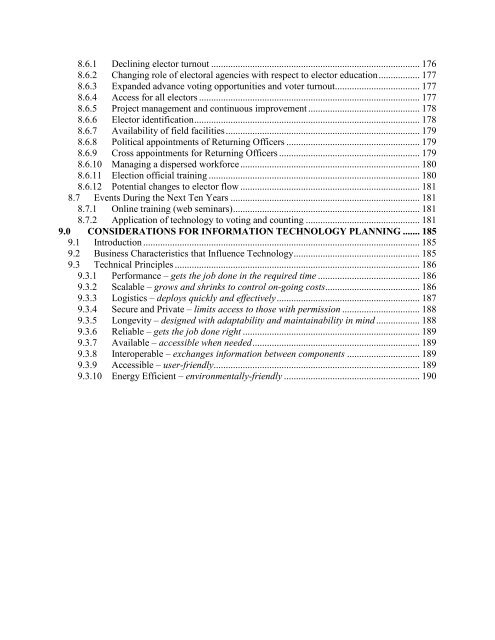Electoral-Management-Reference-Model-v.1.0
Electoral-Management-Reference-Model-v.1.0
Electoral-Management-Reference-Model-v.1.0
Create successful ePaper yourself
Turn your PDF publications into a flip-book with our unique Google optimized e-Paper software.
8.6.1 Declining elector turnout ...................................................................................... 176<br />
8.6.2 Changing role of electoral agencies with respect to elector education ................. 177<br />
8.6.3 Expanded advance voting opportunities and voter turnout ................................... 177<br />
8.6.4 Access for all electors ........................................................................................... 177<br />
8.6.5 Project management and continuous improvement .............................................. 178<br />
8.6.6 Elector identification ............................................................................................. 178<br />
8.6.7 Availability of field facilities ................................................................................ 179<br />
8.6.8 Political appointments of Returning Officers ....................................................... 179<br />
8.6.9 Cross appointments for Returning Officers .......................................................... 179<br />
8.6.10 Managing a dispersed workforce .......................................................................... 180<br />
8.6.11 Election official training ....................................................................................... 180<br />
8.6.12 Potential changes to elector flow .......................................................................... 181<br />
8.7 Events During the Next Ten Years .............................................................................. 181<br />
8.7.1 Online training (web seminars) ............................................................................. 181<br />
8.7.2 Application of technology to voting and counting ............................................... 181<br />
9.0 CONSIDERATIONS FOR INFORMATION TECHNOLOGY PLANNING ....... 185<br />
9.1 Introduction .................................................................................................................. 185<br />
9.2 Business Characteristics that Influence Technology .................................................... 185<br />
9.3 Technical Principles ..................................................................................................... 186<br />
9.3.1 Performance – gets the job done in the required time .......................................... 186<br />
9.3.2 Scalable – grows and shrinks to control on-going costs ....................................... 186<br />
9.3.3 Logistics – deploys quickly and effectively ........................................................... 187<br />
9.3.4 Secure and Private – limits access to those with permission ................................ 188<br />
9.3.5 Longevity – designed with adaptability and maintainability in mind .................. 188<br />
9.3.6 Reliable – gets the job done right ......................................................................... 189<br />
9.3.7 Available – accessible when needed ..................................................................... 189<br />
9.3.8 Interoperable – exchanges information between components .............................. 189<br />
9.3.9 Accessible – user-friendly ..................................................................................... 189<br />
9.3.10 Energy Efficient – environmentally-friendly ........................................................ 190


